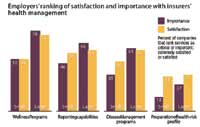Employers not ready to give up on health and wellness programs
Employers are expressing frustration at lack of participation in wellness programs. This is in light of the fact that there was an increase in the number of such programs offered from 2008 to 2010.
EMPLOYERS, like every other stakeholder in the healthcare industry, are under the gun to manage costs and measure the effectiveness of the programs they pay for. They are looking for innovation now more than ever.
"Employers recognize that simply cost-sharing with their employees is not a sustainable approach," says Kathryn Stein, managing director of the Human Resources Group for PricewaterhouseCoopers (PwC). "And they are looking to insurers to help them find a new approach."
PwC recently released "What Employers Want from Health Insurers in 2010." According to the report, large employers' satisfaction with their health insurance carriers has eroded. In the 2008 survey, large employers (more than 250 workers) were generally more satisfied with insurer services than small employers (less than 250 workers). Large employers' satisfaction dropped from 64% in 2008 to 59% in 2010, while small employers' satisfaction remained steady.
The report shows average participation levels at about 50%.
"They want health plans to help them figure out ways of achieving engagement," Stein says. "They want their employees to participate, not just for the short term but for the long run."
MIXED RESULTS
Carl Mowery, managing director of LECG, a business advisory firm that assists employers with compensation and benefit issues, says his clients are at a loss to understand why there is not more employee participation in disease management and wellness programs.
"Even with incentives, you don't get wide participation" he says. "Participation increases yearly but not at near the levels we would like to see. It takes time; it's a long process."
Employers also blame rising healthcare costs on personal behavior of employees, according to Paul Fronstin, director of the Health Research and Education Program for Employee Benefit Research Institute (EBRI).
"They see the obesity rate rising, and they know it is partly tied to behavior," he says.
Employers believe that improving the health habits of their workers is paramount to stemming the tide of the high cost of healthcare. Tailoring their benefit packages to focus on prevention, participation in disease management and wellness programs, employers can influence employee behavior.
Some firms still don't have prevention and wellness benefit packages, but managed care companies believe more will adopt them because it's their best opportunity to get a handle on rising costs. Those that do offer wellness and DM are likely to continue even without a huge financial returns.

Optimal incentives can vary depending on the population targeted and the type of program the employer or plan sponsor offers. Cash rewards or premium reductions-within legal limits-are often the incentives of choice.
"Employers have taken to heart the notion that a healthier employee population pays off in multiple ways," says Jim Eppel, senior vice president of Commercial Markets and Health Management for BCBS of Minnesota. "Some of it is positive paternalism. There is a recognition by employers that the burden of illness transcends medical costs. It affects productivity and other areas. They really want to talk more about how we go about improving the health of their population."
Why Patient Registries Need to Make the Move From Tactical to Strategic Research Initiatives
September 6th 2022The one-sided, research-oriented approach has to change so patients have ready access to dashboards with their disease histories and pre-visit documents tailored to the patient questions.
Read More
Study: Patients with High Deductible Plans More Likely to Delay Care
September 7th 2021Patients faced with high out-of-pocket costs sometimes delay seeking care for appendicitis or diverticulitis, which can result in higher overall costs, increased risk of mortality, and a worse quality of life.
Read More